Charles M. Kozierok The TCP-IP Guide
Подождите немного. Документ загружается.

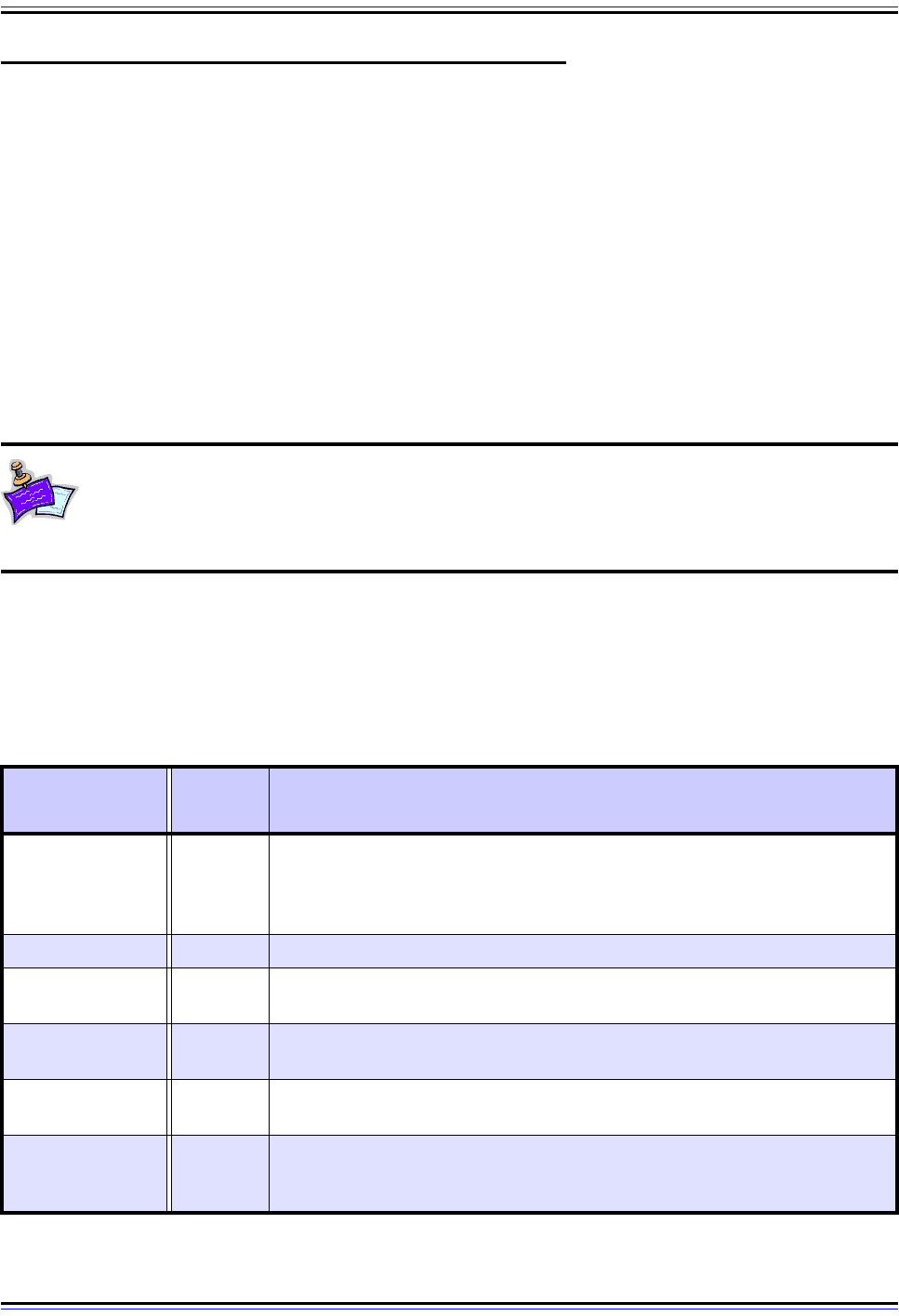
The TCP/IP Guide - Version 3.0 (Contents) ` 661 _ © 2001-2005 Charles M. Kozierok. All Rights Reserved.
ICMPv6 Echo Request and Echo Reply Messages
IP is a relatively simple protocol that does not itself include any method for performing tests
between devices to help in diagnosing internetwork problems. This means that this job, like
other support tasks, falls to ICMP. The simplest test performed when there is a problem
using TCP/IP is usually a check that a pair of devices is able to send datagrams to each
other. This is most often done by an initiating device sending a test message to a second
device, which receives it and replies back to tell the first device it received the message.
Like ICMPv4, ICMPv6 includes a pair of messages specifically for connection testing. To
use them, Device A begins the test process by sending an ICMPv4 Echo Request message
to Device B. Device B responds back to Device A with an Echo Reply message. When
Device A receives this message, it knows that it is able to communicate (both send and
receive) successfully with Device B.
Note: As a side note, in ICMPv4, the first message type was named just Echo but
was often called Echo Request instead. In ICMPv6 they finally just added the
“Request” to the message name and were done with it. A modest but useful
improvement from a clarity standpoint.
ICMPv6 Echo and Echo Reply Message Format
The format for ICMPv6 Echo Request and Echo Reply messages is very similar to that of
the ICMPv4 version, as shown in Table 109 and Figure 157.
Table 109: ICMPv6 Echo Request and Echo Reply Message Format
Field Name
Size
(bytes)
Description
Type 1
Type: Identifies the ICMPv6 message type; for Echo Request messages
the value is 128, and for Echo Reply messages 129. (Recall that in
ICMPv6, informational messages always have a Type value of 128 or
higher.)
Code 1 Code: Not used; set to 0.
Checksum 2
Checksum: 16-bit checksum field for the ICMP header, as described in the
topic on the ICMP common message format.
Identifier 2
Identifier: An optional identification field that can be used to help in
matching Echo Request and Echo Reply messages.
Sequence
Number
2
Sequence Number: A sequence number to help in matching Echo
Request and Echo Reply messages.
Optional Data Variable
Optional Data: Additional optional data to be sent along with the message.
If this is sent in the Echo Request it is copied into the Echo Reply to be
sent back to the source.
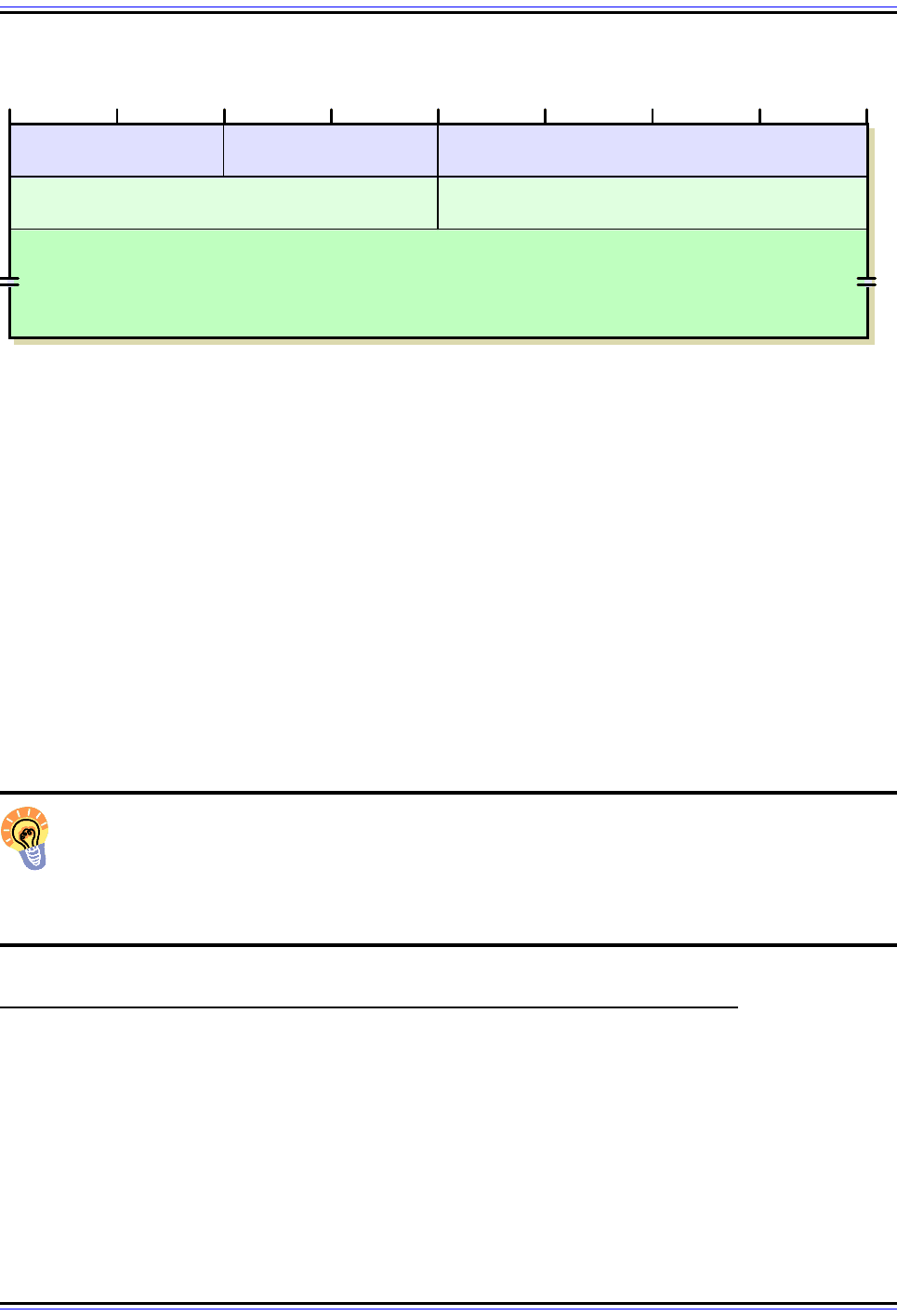
The TCP/IP Guide - Version 3.0 (Contents) ` 662 _ © 2001-2005 Charles M. Kozierok. All Rights Reserved.
As with ICMPv4, it is often necessary to match an Echo Reply message with the Echo
Request message that led to it being generated. Two special fields are used within the
format of these messages to allow Echo Request and Echo Reply messages to be matched
together, and to allow a sequence of messages to be exchanged. The Identifier field is
provided so a particular test session can be identified, and the Sequence Number field
allows a series of tests in a session to be numbered. The use of both fields is optional.
Application of Echo and Echo Reply Messages
ICMPv6 Echo Request and Echo Reply messages are used via the IPv6 version of the IP
ping utility, commonly called ping6. Like its IPv4 predecessor this utility allows an adminis-
trator to configure a number of test options to perform either a simple or rigorous test of the
connection between a pair of devices. See the topic describing ping for a full explanation.
Key Concept: ICMPv6 Echo Request and Echo Reply messages are used to facil-
itate network reachability testing. A device tests its ability to communicate with
another by sending it an Echo Request message and waiting for an Echo Reply in
response. The ping utility, a widely-used diagnostic tool in TCP/IP internetworks, makes use
of these messages.
ICMPv6 Router Advertisement and Router Solicitation Messages
At the highest level, we can separate IP devices into two groups: hosts and routers. Both
participate in the use of the internetwork, but they have different roles. An important IP
principle related to this division is that routers take care of routing—moving data between
networks—while hosts generally don't need to worry about this job. Hosts rely on the
routers on their local networks to facilitate communication to all other hosts except those on
the local network.
Figure 157: ICMPv6 Echo Request and Echo Reply Message Format
Type = 128 or 129 Code = 0 Checksum
Identifier Sequence Number
Optional Data
4 8 12 16 20 24 28 320

The TCP/IP Guide - Version 3.0 (Contents) ` 663 _ © 2001-2005 Charles M. Kozierok. All Rights Reserved.
The implications of this are clear: a host cannot really use an internetwork until it knows the
identity of at least one local router, and the method by which that router is to be used. In
IPv4, a technique known as router discovery was invented, which provides a means by
which a host can locate a router and learn important parameters related to the operation of
the local network.
Router discovery in IPv6 works in a very similar manner, by having routers send Router
Advertisement messages both on a regular basis and in response to hosts prompting for
them using Router Solicitation messages. The router discovery function has been incorpo-
rated into the Neighbor Discovery (ND) protocol, where it is part of a larger class of tools
that I call host-router discovery functions.
ICMPv6 Router Advertisement Message Format
The formats of the ICMPv6 Router Advertisement and Router Solicitation messages are
fairly similar to their counterparts in ICMPv4. The main differences are in the parameters
that are communicated. Since routers are responsible for a few more functions in IPv6 than
they are in IPv4, the Router Advertisement message in ICMPv6 has a few more fields than
the older version.
The format of an ICMPv6 Router Advertisement message is described in Table 110 and
shown in Figure 158.
Table 110: ICMPv6 Router Advertisement Message Format (Page 1 of 2)
Field Name
Size
(bytes)
Description
Type 1
Type: Identifies the ICMPv6 message type; for Router Advertisement
messages the value is 134.
Code 1 Code: Not used; set to 0.
Checksum 2
Checksum: 16-bit checksum field for the ICMP header, as described in the
topic on the ICMP common message format.
Cur Hop Limit 1
Current Hop Limit: This is a default value the router is telling hosts on the
local network they should put in the Hop Limit field of datagrams they send.
If 0, the router is not recommending a Hop Limit value in this Router
Advertisement.
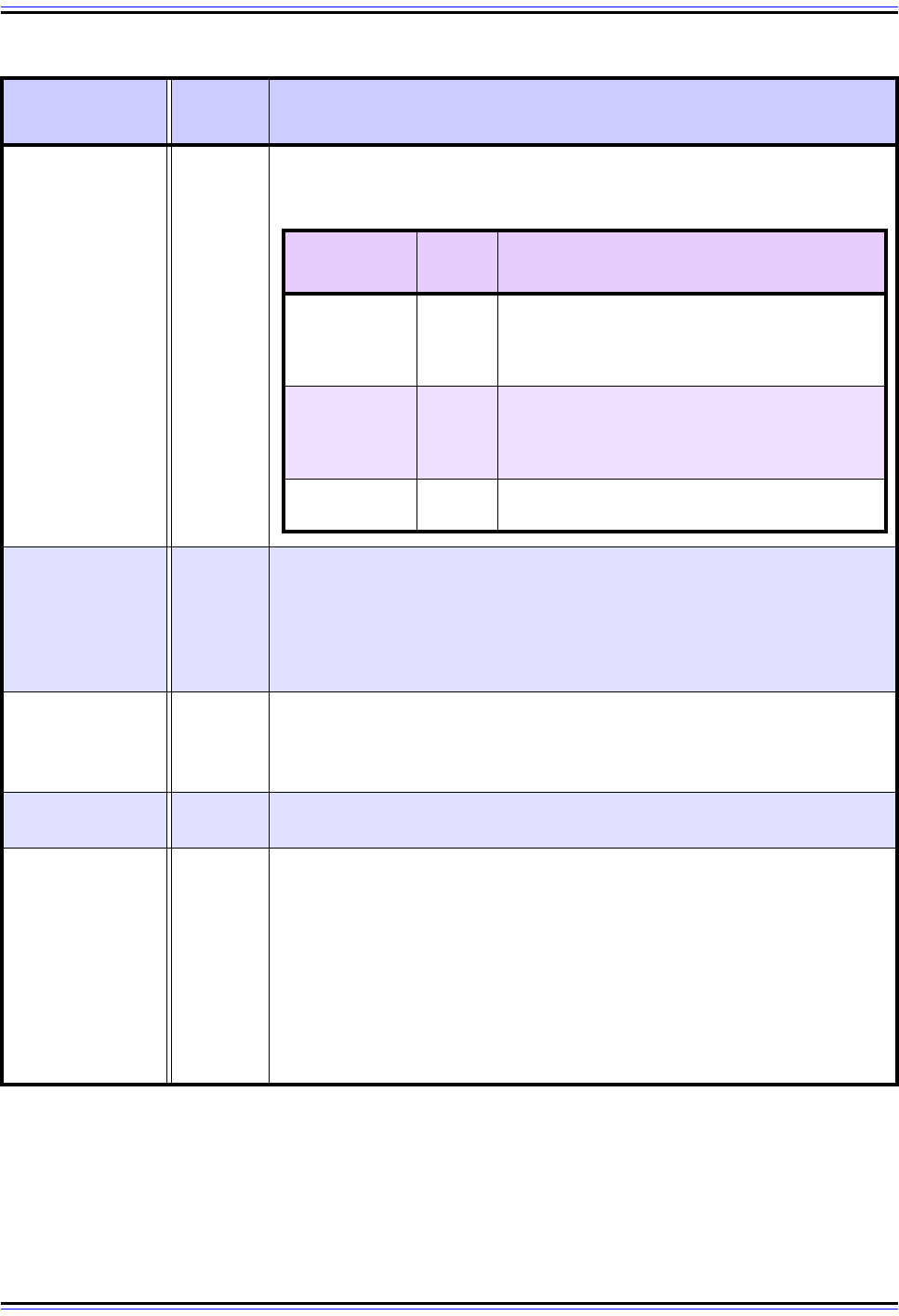
The TCP/IP Guide - Version 3.0 (Contents) ` 664 _ © 2001-2005 Charles M. Kozierok. All Rights Reserved.
Autoconfig Flags 1
Router Lifetime 2
Router Lifetime: Tells the host receiving this message how long, in
seconds, this router should be used as a default router. If 0, tells the host
this router should not be used as a default router.
Note that this is an expiration interval only for the status of the router as a
default, not for other information in the Router Advertisement message.
Reachable Time 4
Reachable Time: Tells hosts how long, in milliseconds, they should
consider a neighbor to be reachable after they have received reachability
confirmation. See the Neighbor Discovery topic discussing neighbor
unreachability detection for more.
Retrans Timer 4
Retransmission Timer: The amount of time, in milliseconds, that a host
should wait before retransmitting Neighbor Solicitation messages.
Options Variable
Options: Router Advertisement messages may contain three possible
options (see the topic on ICMPv6 options for details):
☯ Source Link-Layer Address: Included when the router sending the
Advertisement knows its link-layer (layer two) address.
☯ MTU: Used to tell local hosts the MTU of the local network when this
information may not be known by hosts on the network.
☯ Prefix Information: Tells local hosts what prefix or prefixes to use
for the local network. (Recall that the “prefix” indicates which bits of
an IPv6 address are the network identifier compared to the host
identifier; it is thus analogous to an IPv4 subnet mask).
Table 110: ICMPv6 Router Advertisement Message Format (Page 2 of 2)
Field Name
Size
(bytes)
Description
A
u
t
ocon
fi
gura
ti
on
Fl
ags:
T
wo
fl
ags
th
a
t
l
e
t
th
e rou
t
er
t
e
ll
th
e
h
os
t
h
ow
autoconfiguration is performed on the local network. See the topic on IPv6
autoconfiguration for more details:
Subfield
Name
Size
(bytes)
Description
M
1/8
(1 bit)
Managed Address Configuration Flag: When
set, this flag tells hosts to use an administered or
“stateful” method for address autoconfiguration,
such as DHCP.
O
1/8
(1 bit)
Other Stateful Configuration Flag: When set,
tells hosts to use an administered or “stateful”
autoconfiguration method for information other
than addresses.
Reserved
6/8
(6 bits)
Reserved: Reserved for future use; sent as
zeroes.
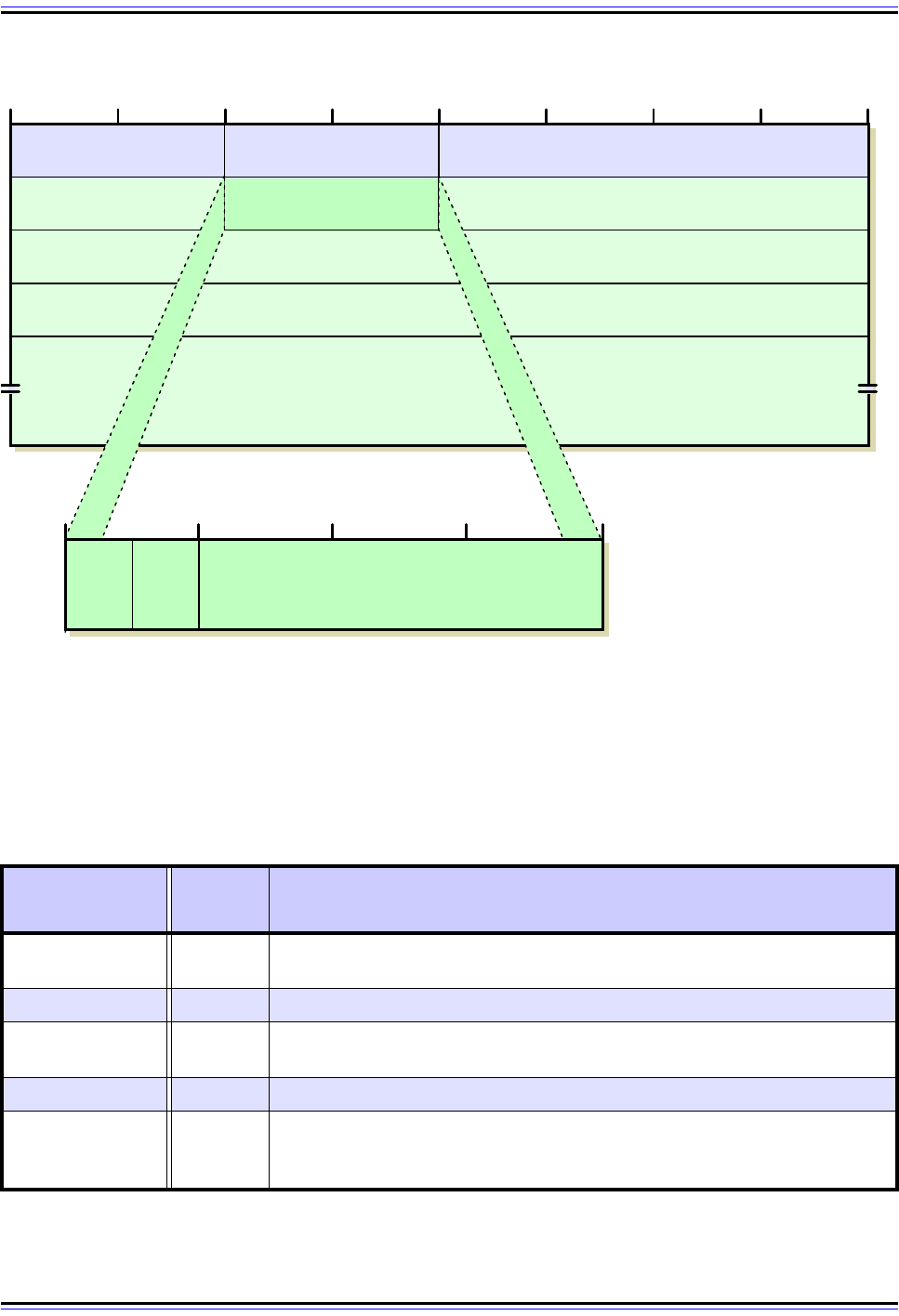
The TCP/IP Guide - Version 3.0 (Contents) ` 665 _ © 2001-2005 Charles M. Kozierok. All Rights Reserved.
ICMPv6 Router Solicitation Message Format
The format of an ICMPv6 Router Solicitation message is as shown Tab le 111 and Figure
159.
Figure 158: ICMPv6 Router Advertisement Message Format
Table 111: ICMPv6 Router Solicitation Message Format
Field Name
Size
(bytes)
Description
Type 1
Type: Identifies the ICMPv6 message type; for Router Solicitation
messages the value is 133.
Code 1 Code: Not used; set to 0.
Checksum 2
Checksum: 16-bit checksum field for the ICMP header, as described in the
topic on the ICMP common message format.
Reserved 4 Reserved: 4 reserved bytes set to 0.
Options Variable
Options: If the device sending the Router Solicitation knows its layer two
address, it should be included in a Source Link-Layer Address option.
Option formats are described in a separate topic.
Type = 134 Code = 0 Checksum
Current Hop Limit
Autoconfig Flags
Router Lifetime
ICMPv6 Options
4 8 12 16 20 24 28 320
240
Managed
Address
Config
Flag (M)
Other
Stateful
Config
Flag (O)
Reserved
86
Retransmission Timer
Reachable Time
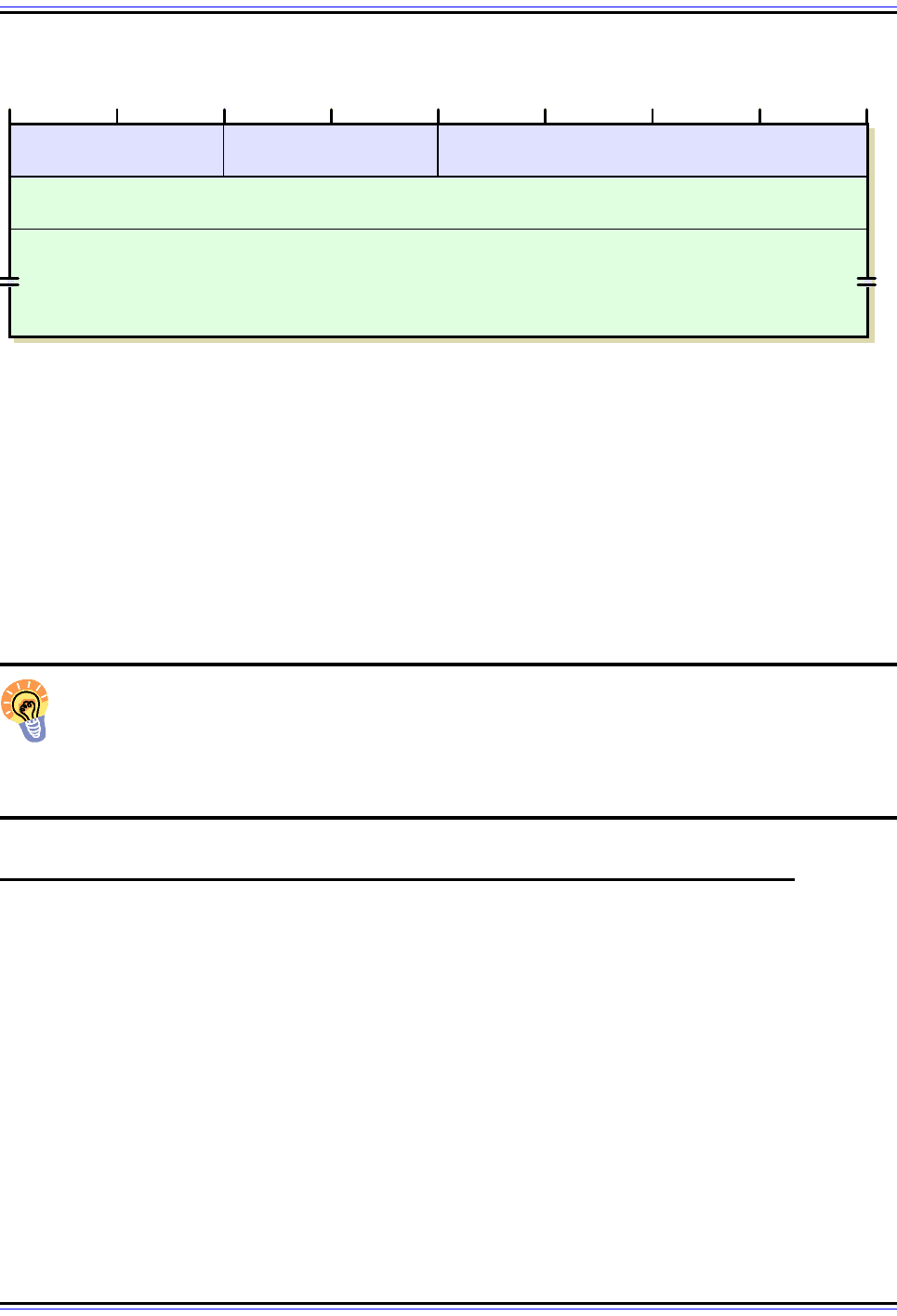
The TCP/IP Guide - Version 3.0 (Contents) ` 666 _ © 2001-2005 Charles M. Kozierok. All Rights Reserved.
Addressing of Router Advertisement and Router Solicitation Messages
Router Solicitation messages are normally sent to the IPv6 “all routers” multicast address;
this is the most efficient method since routers are required to subscribe to this multicast
address while hosts will ignore it. A routine (unsolicited) Router Advertisement is sent to all
devices using the “all nodes” multicast address for the local network. A Router Adver-
tisement that is sent in response to a Router Solicitation goes unicast back to the device
that sent the solicitation.
Key Concept: ICMPv6 Router Advertisement messages are sent regularly by IPv6
routers to inform hosts of their presence and characteristics, and to provide hosts
with parameters they need to function properly on the local network. A host that
wants to find out immediately what routers are present may send a Router Solicitation,
which will prompt listening routers to send out Router Advertisements.
ICMPv6 Neighbor Advertisement and Neighbor Solicitation Messages
The previous topic described the Router Advertisement and Router Solicitation messages,
which are used to facilitate host-router discovery functions as part of the IPv6 Neighbor
Discovery (ND) protocol. The other main group of tasks for which ND is responsible relates
to the exchange of information between neighboring hosts on the same network. I call these
host-host communication or host-host discovery functions.
Arguably, the most important additions to the Neighbor Discovery protocol are the functions
that formalize the exchange of parameters, and the methods for determining the existence
of neighboring hosts. These tasks include the new method of address resolution in IPv6, as
well the processes of next-hop determination and neighbor unreachability detection. They
require the use of two ICMPv6 messages: the Neighbor Solicitation message and the
Neighbor Advertisement message.
Figure 159: ICMPv6 Router Solicitation Message Format
Type = 133 Code = 0 Checksum
Reserved
ICMPv6 Options
4 8 12 16 20 24 28 320
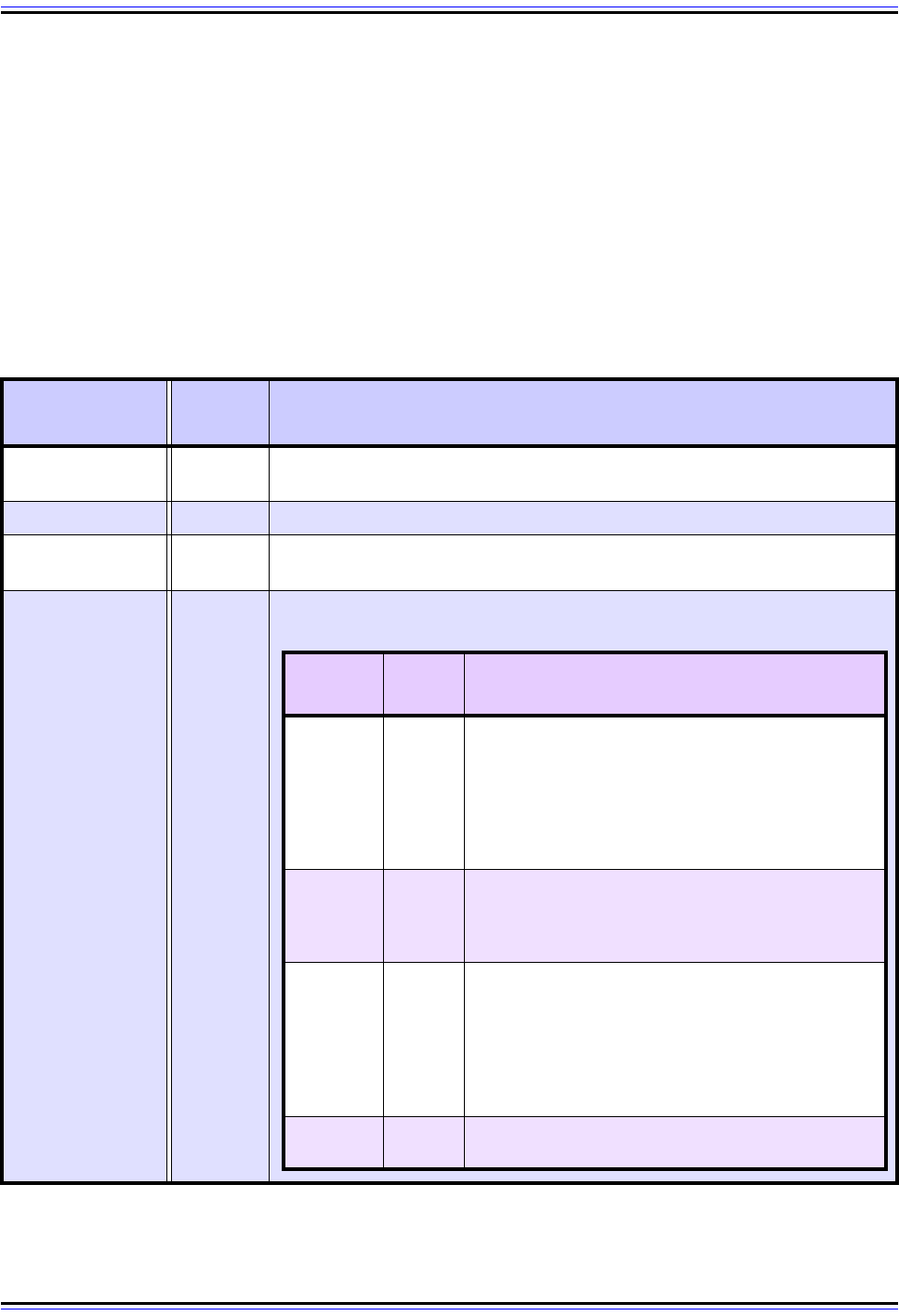
The TCP/IP Guide - Version 3.0 (Contents) ` 667 _ © 2001-2005 Charles M. Kozierok. All Rights Reserved.
The Neighbor Solicitation message allows a device to check that a neighbor exists and is
reachable, and to initiate address resolution. The Neighbor Advertisement message
confirms the existence of a host or router, and also provides layer-two address information
when needed. As you can see, these two messages are comparable to the Router Adver-
tisement and Router Solicitation messages, but are used differently and include different
parameters.
ICMPv6 Neighbor Advertisement Message Format
The format for the Neighbor Advertisement message is described in Table 112 and Figure
160.
Table 112: ICMPv6 Neighbor Advertisement Message Format (Page 1 of 2)
Field Name
Size
(bytes)
Description
Type 1
Type: Identifies the ICMPv6 message type; for Neighbor Advertisement
messages the value is 136.
Code 1 Code: Not used; set to 0.
Checksum 2
Checksum: 16-bit checksum field for the ICMP header, as described in the
topic on the ICMP common message format.
Flags 4
Fl
ags:
Th
ree
fl
ags
th
a
t
convey
i
n
f
orma
ti
on a
b
ou
t
th
e message
(
an
d
l
o
t
s o
f
emp
t
y
space for future use):
Subfield
Name
Size
(bytes)
Description
R
1/8
(1 bit)
Router Flag: Set when a router sends a Neighbor
Advertisement, and cleared when a host sends one.
This identifies the type of device that sent the
datagram, and is also used as part of Neighbor
Unreachability Detection to detect when a device
changes from acting as a router to functioning as a
regular host.
S
1/8
(1 bit)
Solicited Flag: When set, indicates that this message
was sent in response to a Neighbor Solicitation
message. Cleared for unsolicited Neighbor
Advertisements.
O
1/8
(1 bit)
Override Flag: When set, tells the recipient that the
information in this message should override any
existing cached entry for the link-layer address of this
device. This bit is normally set in unsolicited Neighbor
Advertisements since these are sent when a host
needs to force a change of information in the caches of
its neighbors.
Reserved
3 5/8
(29 bits)
Reserved: A big whomping set of reserved bits. ☺
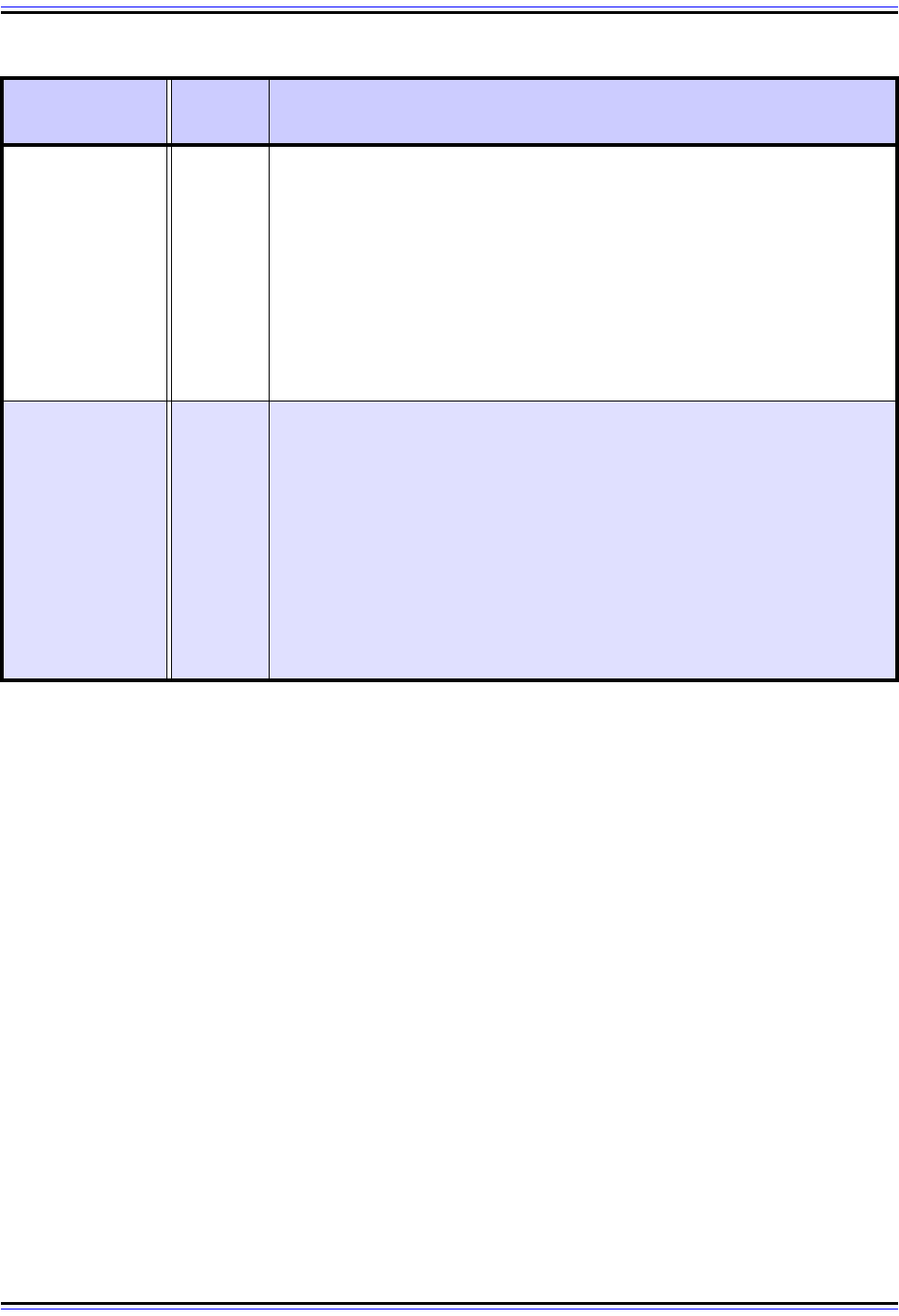
The TCP/IP Guide - Version 3.0 (Contents) ` 668 _ © 2001-2005 Charles M. Kozierok. All Rights Reserved.
Target Address 16
Target Address: If the Neighbor Advertisement is being sent in response
to a Neighbor Solicitation, this is the same value as in the Target Address
field of the Solicitation. This field will commonly contain the IPv6 address of
the device sending the Neighbor Advertisement, but not in all cases. For
example, if a device responds as a proxy for the target of the Neighbor
Solicitation, the Target Address field contains the address of the target, not
the device sending the response. See the topic on address resolution
proxying for details.
If the Neighbor Advertisement is being sent unsolicited, then this is the
IPv6 address of the device sending it.
Options Variable
Options: When sent in response to a multicast Neighbor Solicitation, a
Neighbor Advertisement message must contain a Target Link-Layer
Address option, which carries the link-layer address of the device sending
the message. This is a good example of an “option” that's not really
“optional”. ☺
When the Neighbor Advertisement is sent in response to a unicast
Neighbor Solicitation, this option is technically not required (since the
sender of the Solicitation must already have the target's link-layer address
to have sent it unicast.) Despite this, it is still normally included, to ensure
that the link-layer address of the target is refreshed in the cache of the
device that sent the Neighbor Solicitation.
Table 112: ICMPv6 Neighbor Advertisement Message Format (Page 2 of 2)
Field Name
Size
(bytes)
Description
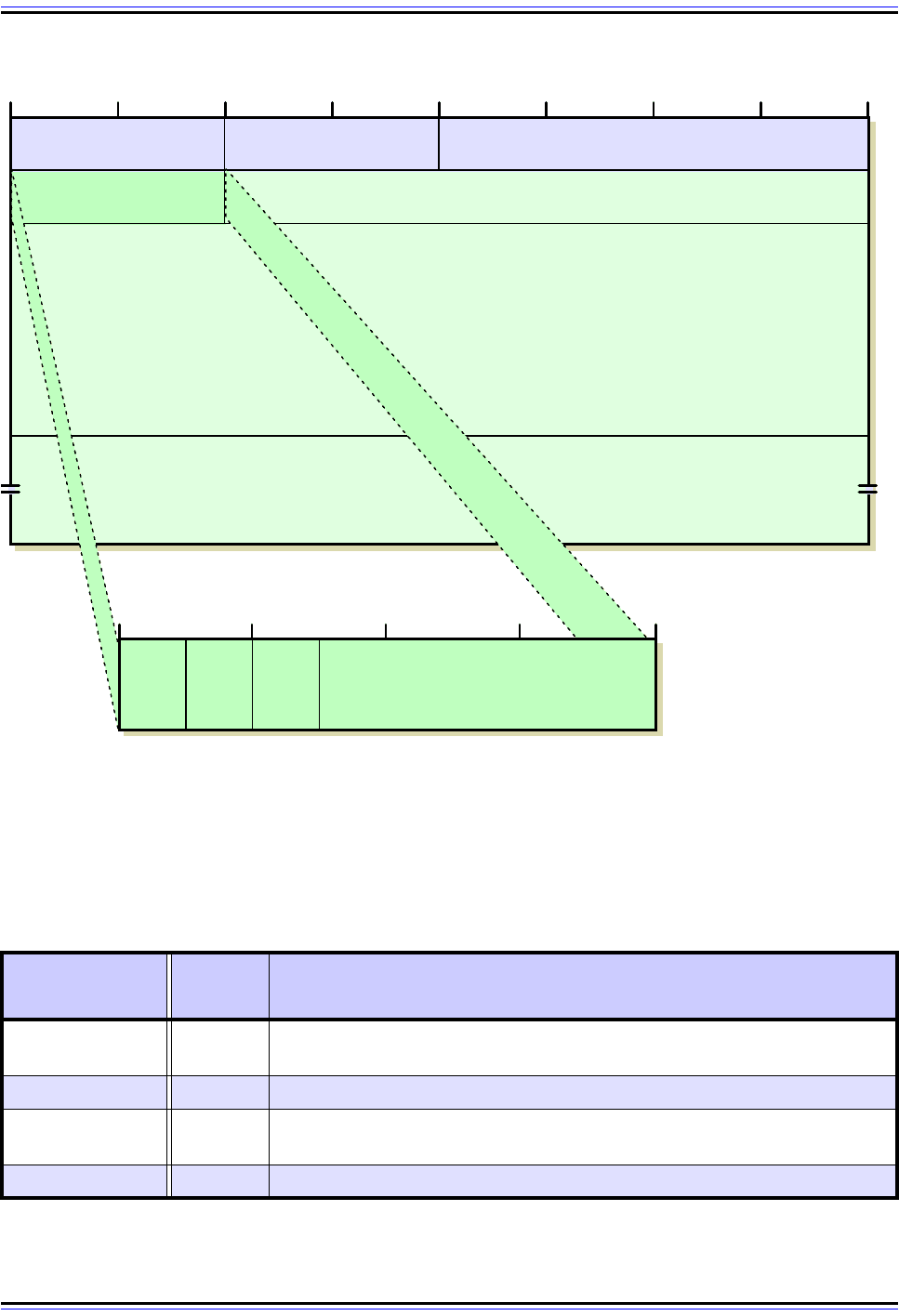
The TCP/IP Guide - Version 3.0 (Contents) ` 669 _ © 2001-2005 Charles M. Kozierok. All Rights Reserved.
ICMPv6 Neighbor Solicitation Message Format
The Neighbor Solicitation message format is much simpler, as depicted in Table 113 and
Figure 161.
Figure 160: ICMPv6 Neighbor Advertisement Message Format
Table 113: ICMPv6 Neighbor Solicitation Message Format (Page 1 of 2)
Field Name
Size
(bytes)
Description
Type 1
Type: Identifies the ICMPv6 message type; for Neighbor Solicitation
messages the value is 135.
Code 1 Code: Not used; set to 0.
Checksum 2
Checksum: 16-bit checksum field for the ICMP header, as described in the
topic on the ICMP common message format.
Reserved 4 Reserved: 4 reserved bytes set to 0.
Type = 136 Code = 0 Checksum
Flags Reserved
Target Address
I
4 8 12 16 20 24 28 320
240
Router
Flag
(R)
Solicited
Flag
(S)
Override
Flag
(O)
Reserved
86
ICMPv6 Options
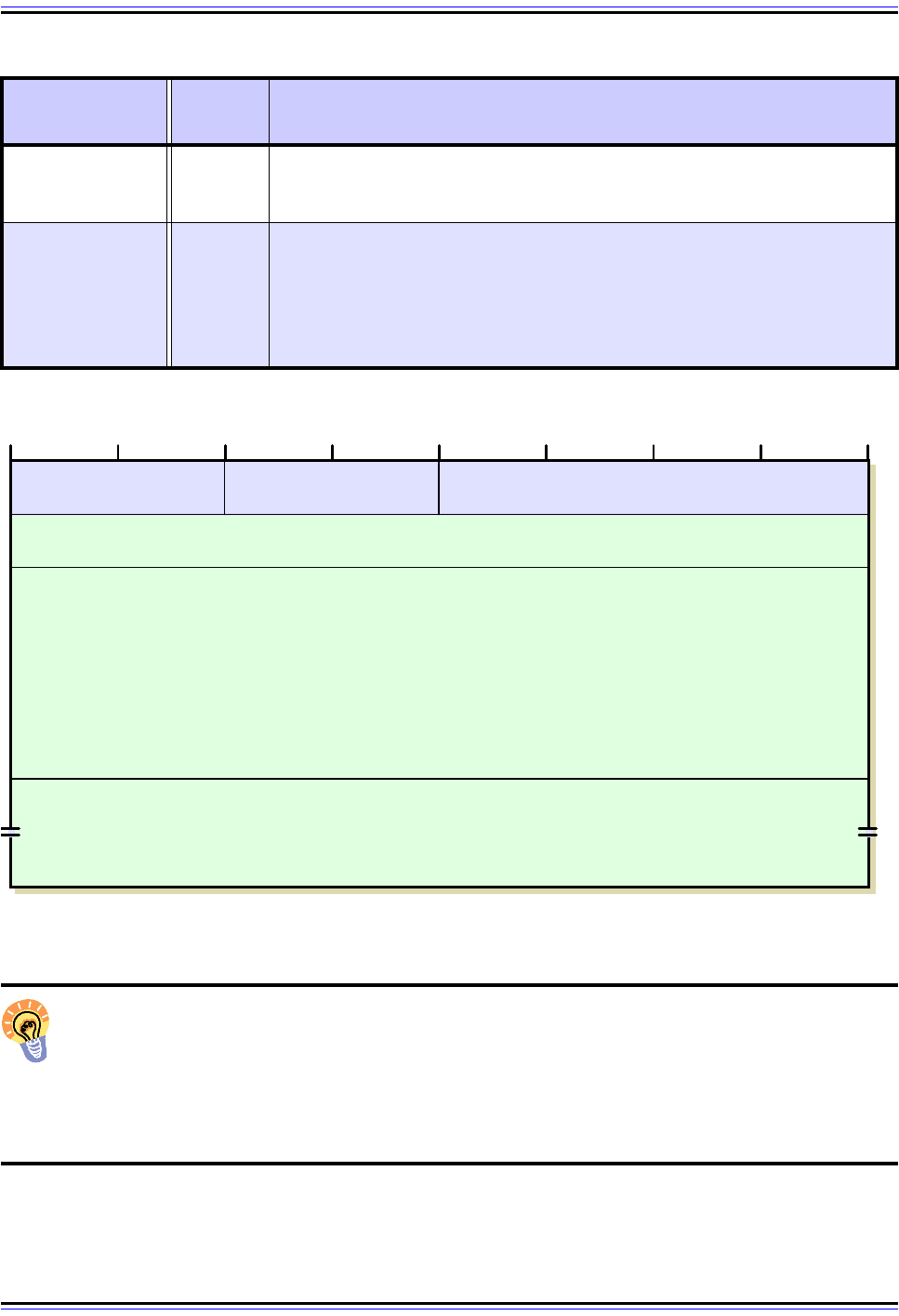
The TCP/IP Guide - Version 3.0 (Contents) ` 670 _ © 2001-2005 Charles M. Kozierok. All Rights Reserved.
Key Concept: ICMPv6 Neighbor Advertisement and Neighbor Solicitation messages
are similar in many ways to the Router Advertisement and Router Solicitation
messages. However, rather than being used to communicate parameters from
routers to hosts, they are used for various types of communication between hosts on a
physical network, such as address resolution, next-hop determination and neighbor
unreachability detection.
Target Address 16
Target Address: The IPv6 address of the target of the solicitation. For
IPv6 address resolution, this is the actual unicast IP address of the device
whose layer two (link-layer) address we are trying to resolve.
Options Variable
Options: If the device sending the Neighbor Solicitation knows both its
own IP address and layer two address, it should include the layer two
address in a Source Link-Layer Address option. The inclusion of this option
will allow the destination of the Neighbor Solicitation to enter the layer two
and layer three addresses of the source of this message into its own
address cache. See the discussion of IPv6 address resolution.
Figure 161: ICMPv6 Neighbor Solicitation Message Format
Table 113: ICMPv6 Neighbor Solicitation Message Format (Page 2 of 2)
Field Name
Size
(bytes)
Description
Type = 135 Code = 0 Checksum
Reserved
Target Address
ICMPv6 Options
4 8 12 16 20 24 28 320
